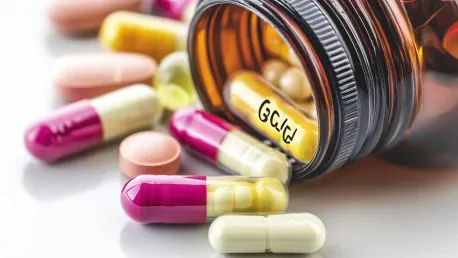In a transformative study examining the impact of GLP-1 receptor agonist drugs on post-surgical outcomes for diabetic patients, researchers have discovered significant reductions in post-surgical complications when these medications are part of the regimen. Drugs like tirzepatide and semaglutide, originally intended for managing blood sugar levels, have shown promising secondary benefits that extend far beyond their primary purpose. People with diabetes face a significantly heightened risk of post-surgical complications, including hospital readmission, wound re-opening, and hematoma formation. It is within this context that GLP-1 drugs present a potential paradigm shift.
The study highlighted that diabetic patients taking GLP-1 receptor agonists experienced approximately a 12% lower risk of hospital readmission within a month following surgery. Furthermore, these patients displayed a striking 29% reduction in the likelihood of wound re-opening within six months and an astounding 56% lower risk of developing a hematoma at the surgery site compared to their counterparts not on these medications. These statistics underscore the drugs’ potential to substantially mitigate the risks associated with surgical procedures in diabetic patients. The functionality of GLP-1 drugs includes activating the GLP-1 receptor on cells within the pancreas and various other organs, thereby stimulating insulin release and lowering blood sugar and appetite. However, the beneficial post-surgical outcomes might be more intricately linked with other physiological effects exerted by the medications.
Mechanisms Behind Reduced Complications
While it is natural to attribute better post-surgical outcomes in diabetic patients to improved blood sugar control, the study found an intriguing twist. Patients on GLP-1 drugs had higher average blood sugar levels compared to those who were not. This suggests that the drugs’ impacts might be derived from mechanisms beyond mere glucose regulation. Researchers propose that GLP-1 drugs’ ability to prevent clotting, promote blood vessel formation, and reduce inflammation could be crucial in post-surgical recovery. These mechanisms collectively aid in wound healing, providing a plausible explanation for the reduced complications observed.
The findings initiated a critical realization that while GLP-1 receptor agonists excel at blood sugar control, their true marvel in post-surgical contexts might arise from enhancing the body’s natural healing processes. Preventing clotting and promoting new blood vessel growth are essential elements of regenerating damaged tissues, while reducing inflammation mitigates the risk of complications such as infection and improper healing. Thus, the cascading benefits of these drugs in post-surgical recovery are not merely an extension of their primary effects but rather a suite of supportive physiological actions that collectively enhance patient outcomes.
Statistically Significant Benefits
The study’s robustness is bolstered by its substantial sample size, encompassing a large number of patients and surgical procedures. This extensive scope adds credibility to the findings, as statistical significance becomes more pronounced with larger datasets. The observed benefits—reduced hospital readmissions, decreased wound re-opening, and minimal hematoma risk—embolden the prospects of integrating GLP-1 drugs into post-surgical care for diabetic patients. What stands out is that despite the promising reduction in specific complications, the study noted no significant difference in bleeding and infection rates between those on GLP-1 drugs and those not on them. This nuanced detail enriches the understanding of the scope and limitations of these medications in post-surgical contexts.
The comprehensive evaluation of patients and procedures within the study underscores the reliability of the findings. The granular detail provided by the study ensures that the observed benefits are not artefacts of chance but rather real, reproducible outcomes. This contrasts with the steady bleeding and infection rates, painting a multidimensional view of GLP-1 drugs’ efficacy. The translating of these drugs’ known functionalities into tangible post-surgical benefits marks a substantial step forward in diabetic patient care. The nuanced recognition that not all complications are mitigated ensures that future research is directed towards understanding the drugs’ selective efficacy, rather than broadly attributing all reductions to the GLP-1 receptor agonists.
Future Research and Implications
A groundbreaking study on the impact of GLP-1 receptor agonist drugs on post-surgical outcomes for diabetic patients has shown notable decreases in complications when these medications are included in the treatment plan. Drugs such as tirzepatide and semaglutide, originally designed to manage blood sugar, demonstrate significant secondary benefits. Diabetic patients are at an increased risk of post-surgical issues like readmission, wound re-opening, and hematoma formation. This makes the findings about GLP-1 drugs particularly important.
The research revealed a 12% lower risk of hospital readmission within a month post-surgery for patients on GLP-1 receptor agonists. Additionally, these patients had a 29% lower chance of wound re-opening within six months and a remarkable 56% lower risk of developing a hematoma at the surgical site compared to those not on these drugs. These findings highlight the drugs’ potential to greatly reduce surgical risks in diabetic patients. GLP-1 drugs work by activating receptors on cells in the pancreas and other organs, which stimulates insulin release and reduces blood sugar and appetite. However, the beneficial outcomes might be linked to additional physiological effects of these medications.









